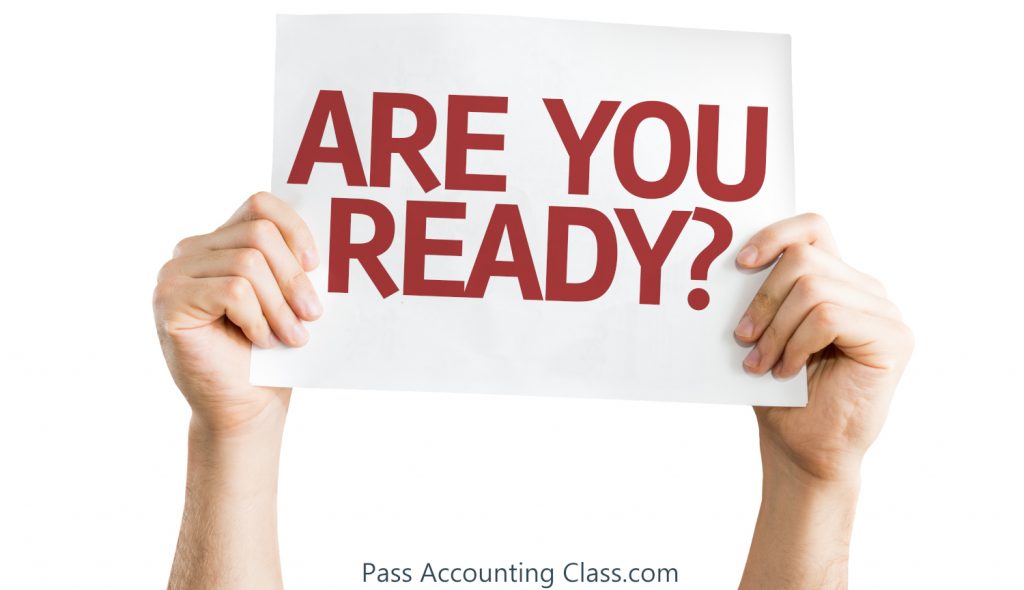Homework questions will only take you so far!
The Truth About Your Accounting Test
Your accounting professor told you that since you’ve completed the homework and understand it, you should be fine for the test. Based on this, you think you know how to study for your accounting test.
Here’s the problem: you’ve done all the homework questions, you think you understand them, and then you get to the test only to realize the accounting test questions are completely different from what you’ve seen in the homework questions. Often times the test questions are multiple-choice. This makes sense because it’s easier for the professor to grade. The test questions look simple enough, but once you try to answer them you realize they’re more complicated than you initially thought.
This is normal. Most of my tutoring students ran into this problem prior to working with me. In fact, I had this exact problem when I was in my first accounting class.
So, just because you’ve done the homework (and understand it) doesn’t mean you’ll do well on the test. This is because test questions focus on selecting the correct answers (which makes it easier to grade) while your homework questions focus on the process to get the correct answer.
Typically this means homework questions are longer, more time-consuming, and more involved compared to test questions. Homework questions usually take you through multiple steps of an accounting process, sequentially. Test questions frequently start you in the middle of an accounting process and ask you to solve for the beginning or ending numbers. Or sometimes test questions just give you bits and pieces and require you to construct the accounting process to find the missing variable(s), and then require you to select the correct answer.
Of course, there is overlap with test and homework questions. In theory, if you answer a test question correctly, it means you understand the process. But what if you answer a test question incorrectly? Does it mean you don’t understand the process?…not necessarily.
Unfortunately, panic sets in when you see different types of questions for the first time on a test. It rattles your confidence. Panic and a lack of confidence derail your best efforts, and despite understanding the homework, now you must take extra time (while taking your test) to figure out how to answer these questions. And if your test has a time limit, this means you feel rushed, which leads to even more panic.
All this panic contributes to a mindset that leads to a bad test experience. Answer test questions incorrectly and you’ll end up with a bad test score, and even worse, a feeling of doubt and lack of confidence. As you can imagine (or maybe have experienced) a bad test score doesn’t necessarily mean you don’t understand the content. It could simply mean you don’t understand the format of the questions or how to approach answering the questions.

So, what’s the solution?
Assuming you’ve done the homework and understand it, you need to practice answering test questions. I know this may seem obvious, but since you’re going to be tested with test questions, it only makes sense to practice answering test questions. Practicing answering test questions reinforces the processes you learned in the homework questions. Additionally, you’ll get more familiar with the multiple-choice format; so, you won’t be unpleasantly surprised on your test.
If your test has homework-style questions on it, you’ll be fine. If your test has multiple choice questions on it, you’ll be fine. The goal with test preparation is to cover your bases and make sure you’re prepared for anything on the test, including the format of the questions.
An accounting test tests your understanding of the material, but it also tests how efficient you are with the material. You know, how quickly can you find the correct answer? Oftentimes, the best way to test efficiency is with multiple choice questions and a time limit.
I can’t tell you the number of times I’ve heard students complain that they didn’t have enough time while taking the test or they felt rushed to finish the test. Yet, when we spend a tutoring session preparing for the test with test questions, those same students seem to have almost too much time while taking the test!
Test questions force you to think a little differently in order to solve the question; the more you practice, the more efficient you’ll be at answering the test questions. And efficiency should translate into a better test score.
Homework question example
To get a better idea of what I’m talking about here’s an abbreviated example of a homework question:
Journalize the following transactions for Smith Co.:
On June 1st, Smith Co. performed services on account for Jan Co. in the amount of $2,000.
On June 15th, Jan Co. paid Smith Co. the amount due from the June 1st transaction.
First, you solve for June 1st by debiting Accounts Receivable for $2,000 and crediting Sales for $2,000. This reinforces that Accounts Receivable represents the amount that customers owe us. It’s an Asset account, and a debit increases the balance of an Asset account. This homework question also reinforces crediting Sales, a Revenue account, when service is performed on account for a customer. A credit increases the balance of a Revenue account.
Next, you solve for June 15th by debiting Cash for $2,000 and crediting Accounts Receivable for $2,000. This reinforces that when Cash is received, we need to debit Cash since Cash is an Asset, and a debit increases the balance of an Asset account. Additionally, this reinforces that when a credit customer pays us the amount they owe, we need to decrease the Accounts Receivable balance because they no longer owe us. This means we need to credit Accounts Receivable because Accounts Receivable is an Asset and a credit decreases the balance of an Asset account.

Accounting test question example
Compare that homework question to this example of a test question:
When a company receives cash from a credit customer on account,
a) Cash is debited and Accounts Payable is credited
b) Cash is debited and Accounts Receivable is credited
c) Accounts Receivable is debited and Cash is credited
d) Accounts Payable is debited and Cash is credited
Notice that this example test question is similar to the example homework questions. The main difference is that the homework question showed us the accounting process from the first transaction or sale (performing services on account) to the second transaction (collection of money).
The test question assumes the first transaction or sale already occurred and puts us in the middle of the sale and collection of money. For the test question, we don’t need to think about the sale, but doing so may help us solve the test question.
Here’s how I solve this test question: What was received? Cash. Cash is an Asset, we increase the balance of Cash (Asset) by debiting it. So, the answer has to be A or B.
Since we’re dealing with a credit customer on account, it means they had a balance they owed us prior to this transaction. An amount a customer owes us is called an Accounts Receivable; it’s an Asset. And since the credit customer paid their balance, we need to decrease the amount they owe us. We decrease the balance of Accounts Receivable (Asset) by crediting it. So the answer is B.
Another accounting test question example
Notice in the test question above, there weren’t any numbers. Dollar amounts are irrelevant because you’re being tested on the accounts impacted by the transaction. Basically, they want to know if you know the journal entry (what accounts you should debit and credit) for this very common transaction.
Similarly, there are fundamental questions that confuse students because there aren’t any numbers involved in the question or answer. For example, here’s an example test question that sometimes confuses students.
Another way to write the basic accounting formula is:
a) Assets – Liabilities = Owner’s Equity
b) Assets = Liabilities + Owner’s Equity
c) Liabilities = Assets – Owner’s Equity
d) All the above are correct
This question should be fairly straightforward as it relates to a fundamental concept in accounting; the accounting equation (aka the basic accounting formula). If you skim this question, you might select B as your answer. Unfortunately, B is only partially correct. This question forces you to think about the accounting equation and alternative ways to write it.
Most homework questions relating to the accounting equation give you dollar amounts associated with accounts and tell you to solve for an account type (asset, liability, or owner’s equity). But this test question looks different than the homework questions and this confuses students. They try to answer this question using theory, whereas I prefer to answer a question like this by plugging in numbers.
Here’s how I solve this test question. I know the basic accounting formula is Assets = Liabilities + Owner’s Equity. Based on this information, the answer is either B or D.
I need to figure out if it’s D, so I need to test answers A and C. To test answers A and C, I assign numbers to the different account types in the basic accounting formula.
So, my basic accounting formula looks like this: Assets (3) = Liabilities (2) + Owner’s Equity (1). Basically, the equation reads 3 = 2 + 1; where Assets = 3, Liabilities = 2, and Owner’s Equity =1.
Now I’m going to apply these numbers to answers A and C.
a) Assets (3) – Liabilities (2) = Owner’s Equity (1), so 3 – 2 = 1 :: this statement is true
c) Liabilities (2) = Assets (3) – Owners’ Equity (1), so 2 = 3 – 1 :: this statement is true
Since answers A, B, and C are true, the answer to the test question is D, all the above are correct.
You know the accounting equation, but the presentation of the question is somewhat confusing and can be misleading. It’s almost as if the person that created the test question wants you to select answer B, it’s so tempting!
As you can see, sometimes it’s easier to solve test questions and makes them easier to grasp when you use numbers. If done properly, plugging numbers in on a test question improves your efficiency.

Important Note
One final point about studying for your accounting test: Knowing what to study is just as important as knowing how to study.
Studying takes time, so you want to become efficient at studying and make the most of your study sessions. You know the phrase, “work smarter, not harder!”
When you practice answering test questions, follow this pattern:
- Answer question 1. Check your answer for question 1. If needed, learn why your answer was incorrect.
- Answer question 2. Check your answer for question 2. If needed, learn why your answer was incorrect.
- Repeat this process for each question.
Unfortunately, most students wait to check their answers until they complete an entire set of practice test questions. So in addition to getting multiple questions wrong and wasting valuable time, they are reinforcing incorrect accounting concepts and processes which makes it more difficult to learn the right way.
For example, I tutored a student that learned the accounting equation incorrectly. He initially learned it as Assets = Liabilities – Equity. (The accounting equation is actually Assets = Liabilities + Owner’s Equity) He completed an entire practice test (approx. 30 questions) and then checked his answers. He got most of them wrong, wasted a bunch of his time, and what’s even worse is that he further reinforced his incorrect understanding of the accounting equation.
Had he checked his answer after the first question, he would have realized he learned the accounting equation incorrectly. He could have then used the correct accounting equation, answered the next questions correctly, further reinforced the proper learning of the accounting equation, and not wasted so much of his time.
Conclusion
You don’t have to be an accounting wizard to pass your accounting test (or class). Most of the time it comes down to proper study habits, knowing what to study and how to study, and knowing when and where to get help.
I’m here to help you succeed. I tutor students all over the US and help them pass their accounting classes. My Pass Accounting Class monthly membership program features video training like the video below, a message board where you can ask me your questions, and discounted rates for one on one tutoring with me. I focus on accounting concepts, homework problems, and test preparation questions. If you need help, reach out, I’d love to help you pass your accounting class! Click here for more information.
